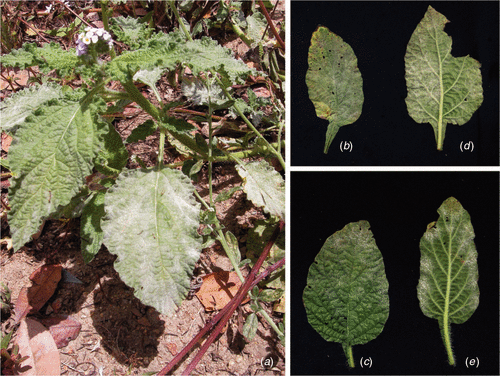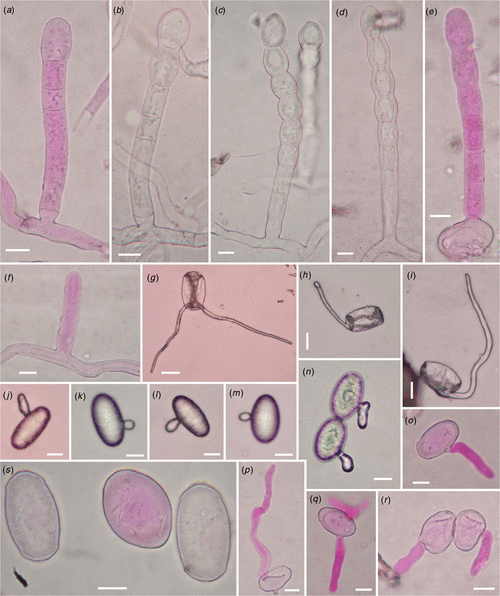First report of Oidium heliotropii-indici on Heliotropium indicum from Brazil
D. J. SoaresEmbrapa Algodão, Rua Oswaldo Cruz, 1143 Centenário, 58428-095 Campina Grande, PB, Brazil. Email: dartjs@yahoo.com.br
Australasian Plant Disease Notes 5(1) 87-89 https://doi.org/10.1071/DN10031
Submitted: 14 June 2010 Accepted: 21 July 2010 Published: 19 August 2010
Abstract
A powdery mildew fungus belonging to the genus Oidium subgen. Fibroidium was found on Heliotropium indicum in north-east Brazil. This fungus was identified as Oidium heliotropii-indici and is described for the first time on this host from Brazil.
Heliotropium indicum L. is an herbaceous plant popularly known as Indian heliotrope that has a pantropical distribution and is usually regarded as a weed. Although widely spread throughout Brazil (Melo and Sales 2004; Melo and Semir 2008), it is of relatively low importance (Lorenzi 2000). In north-east Brazil this plant is frequently found in small populations near humid areas and sometimes as scattered plants throughout drier areas.
In the last 2 years a powdery mildew fungus was consistently found on scattered plants of H. indicum growing inside or near experimental areas of the Embrapa Algodão (Brazilian Center of Cotton Research), in the state of Paraíba. Diseased samples were collected, dried in a botanical press and deposited at the Herbarium of the Universidade Federal de Viçosa, Viçosa, MG, Brazil (Herbarium VIC) (accession number: Vic. 31382).
To identify the powdery mildew fungus microscope slides were prepared by scraping the colonies with a scalpel and also by using an adhesive tape. Lactic acid, lacto-fuchsin and water were used as mounting media. The microscope slides were prepared from fresh material and gently warmed. Measurements were made at a magnification of 1000× using an Olympus microscope. The conidia germination pattern was determined by examining germinated conidia on the natural substrate and following the methodologies described in Cook and Braun (2009).
The fungus description is as follows: colonies white, powdery, on both sides of the leaf, initially as small circular to irregular colonies, later usually covering the entire leaf blade, giving a silvery aspect to the upper side of the leaves (Fig. 1). Mycelium superficial, effuse, 5–10 µm wide, flexuous, hyaline; appressoria indistinct or rarely very slightly nipple-shaped; conidiophores erect, straight to slightly curved, cylindrical, foot cell 45–60 × 10–15 µm, followed by 1–3 shorter cells, hyaline; conidia maturing in chains, ellipsoid-ovoid to doliform, 22–33 × 15–20 µm, l/w ratio 1.5–2.2, usually 1.8, with fibrosin bodies (Fig. 2); germ tubes variable with conidia age, usually lateral; old conidia producing orthotubus subtype of Fibroidium in glass slides at 100% RH; young conidia producing brevitubus subtype of Fibroidium in glass slides and Petri plate lids at 100% RH; no germination was observed on Petri plate lids at 97% RH; on natural substrates germination was consistent with the brevitubus subtype of Fibroidium.

|

|
Based on the description above, the fungus was identified as belonging to the genus Oidium subgen. Fibroidium, anamorph of Podosphaera. According to Cook and Braun (2009) the germination pattern observed here is restricted to Podosphaera sect. Sphaerotheca subsect. Magnicellulatae, although typically ‘branched germ tubes’, were rarely seen (Fig. 2g–r).
No powdery mildews were reported on H. indicum in Brazil (Embrapa 2010; Farr et al. 2010) but several members of Erysiphales have been reported on H. indicum worldwide, namely, Golovinomyces cichoracearum (DC.) V.P. Heluta, Golovinomyces cynoglossi (Wallr.) V.P. Heluta, Erysiphe coluteae (Kom.) U. Braun & S. Takam., Leveillula boraginacearum Golovin, Leveillula boraginacearum f. heliotropii Teich ex Golovin, Leveillula taurica (Lév.) G. Arnaud, Oidium erysiphoides Fr., Oidium heliotropii-indici Sawada, Oidium heliotropii-strigosi [as heliotropii-strigosum] N. Ahmad, A.K. Sarbhoy, Kamal & D.K. Agarwal, Ovulariopsis boraginaceis (Golovin) Cif. & Sousa da Câmara and Podosphaera fuliginea (Schltdl.) U. Braun & S. Takam. (Amano 1986; Farr et al. 2010). Among these L. boraginacearum, L. boraginacearum f. heliotropii and O. boraginaceis are regarded by Braun (1987) as invalid names, but regardless of their nomenclatural status, these species, together with L. taurica, are easily differentiated from the fungus described here since it clearly belongs to the genus Oidium. Golovinomyces cichoracearum and G. cynoglossi can be distinguished mainly by their nipple-shaped appressoria, conidia without fibrosin bodies and germ tube patterns, while E. coluteae can be distinguished by its conidia formed singly and cylindric in shape. Oidium erysiphoides is regarded as a synonym of P. fuliginea (Braun and Takamatsu 2000). Both P. fuliginea and O. heliotropii-indici are closely related to the fungus described here. In his monograph Braun (1987) considered O. heliotropii-indici as an anamorph with uncertain position, and as far the author could ascertain no further treatment was applied to this fungus name. Descriptions of O. heliotropii-indici and the anamorphic state of P. fuliginea provided in Braun’s monograph (Braun 1987) are similar and the main difference is the nipple-shaped appressoria in O. heliotropii-indici in contrast to the indistinct appressoria in P. fuliginea. However, regarding a more recent treatise (Braun et al. 2002) Podosphaera can have either indistinct or nipple-shaped appressoria.
Oidium heliotropii-strigosi recently described on H. strigosum has a similar morphology with O. heliotropii-indici, but O. heliotropii-strigosi differs from O. heliotropii-indici by the following distinctive characteristic: ‘solitary conidia formed on conidiophores with wide foot-cells followed by 1–2 shorter cells’ (Ahmad et al. 2005). The presence of solitary conidia in contrast to catenate conidia is a distinctive characteristic to separate the subgenus Euoidium from Pseudoidium and Fibroidium. However, depending on conditions of the examined specimen, this characteristic can be misinterpreted.
According to Braun’s monograph, P. fuliginea is restricted to Veronica and Veronicastrum hosts within Plantaginaceae and Scrophulariaceae (Braun 1987), so the powdery mildew here fits better with O. heliotropii-indici. Hence this is the first record of this fungus on H. indicum from Brazil.
Acknowledgements
The author thanks the Conselho Nacional de Desenvolvimento Científico e Tecnológico (CNPq) for financial support.
Ahmad N,
Sarbhoy AK,
Kamal
, Agarwal DK
(2005) Five new anamorphic powdery mildews from India. Indian Phytopathology 58, 100–105.
(verified 10 May 2010)
Melo JIM, Sales MF
(2004)
Heliotropium L. (Boraginaceae – Heliotropioidae) de Pernambuco, Nordeste do Brasil. Rodriguésia 55, 65–87.

Melo JIM, Semir J
(2008) Taxonomia do gênero Heliotropium (Heliotropiaceae) no Brasil. Acta Botânica Brasílica 22, 754–770.



